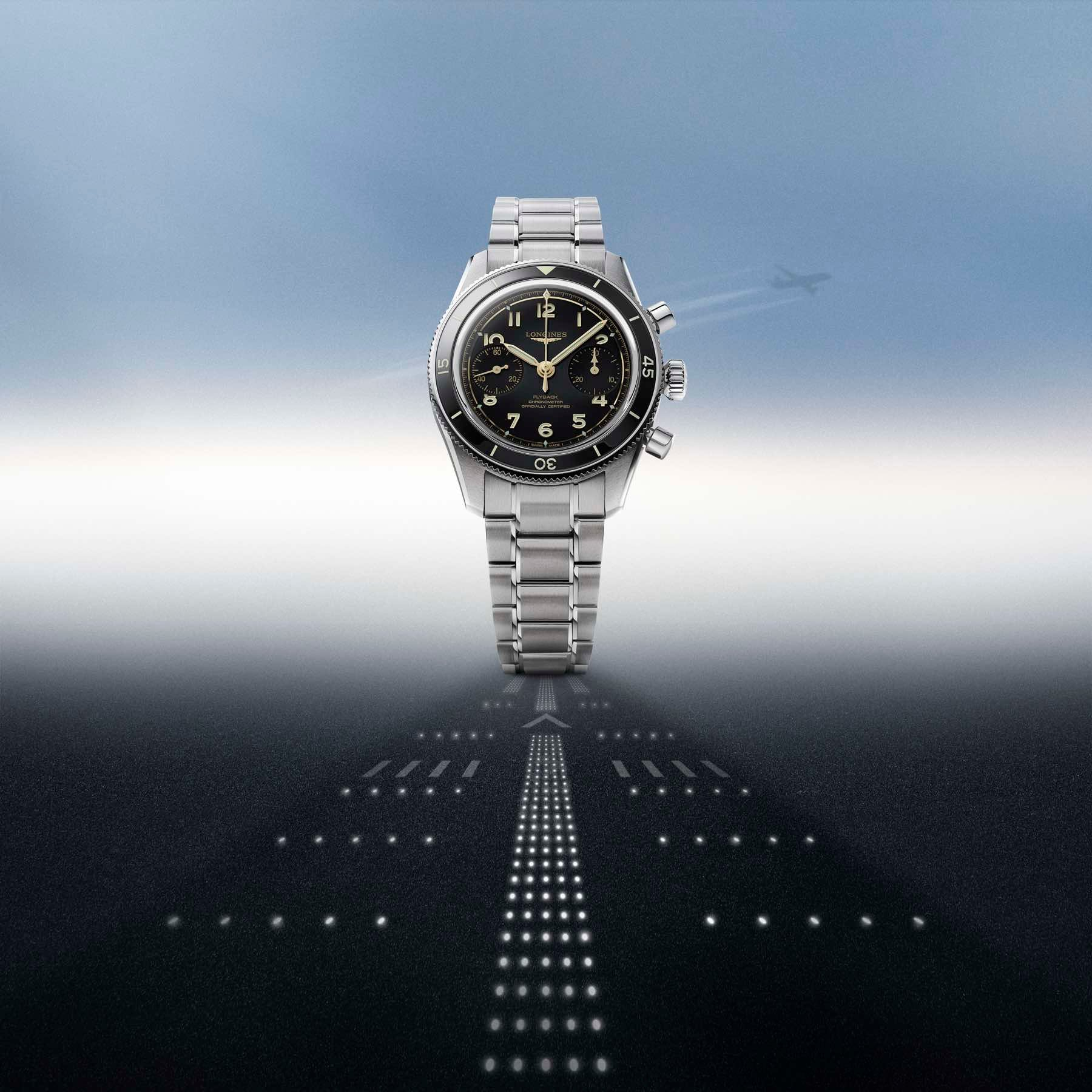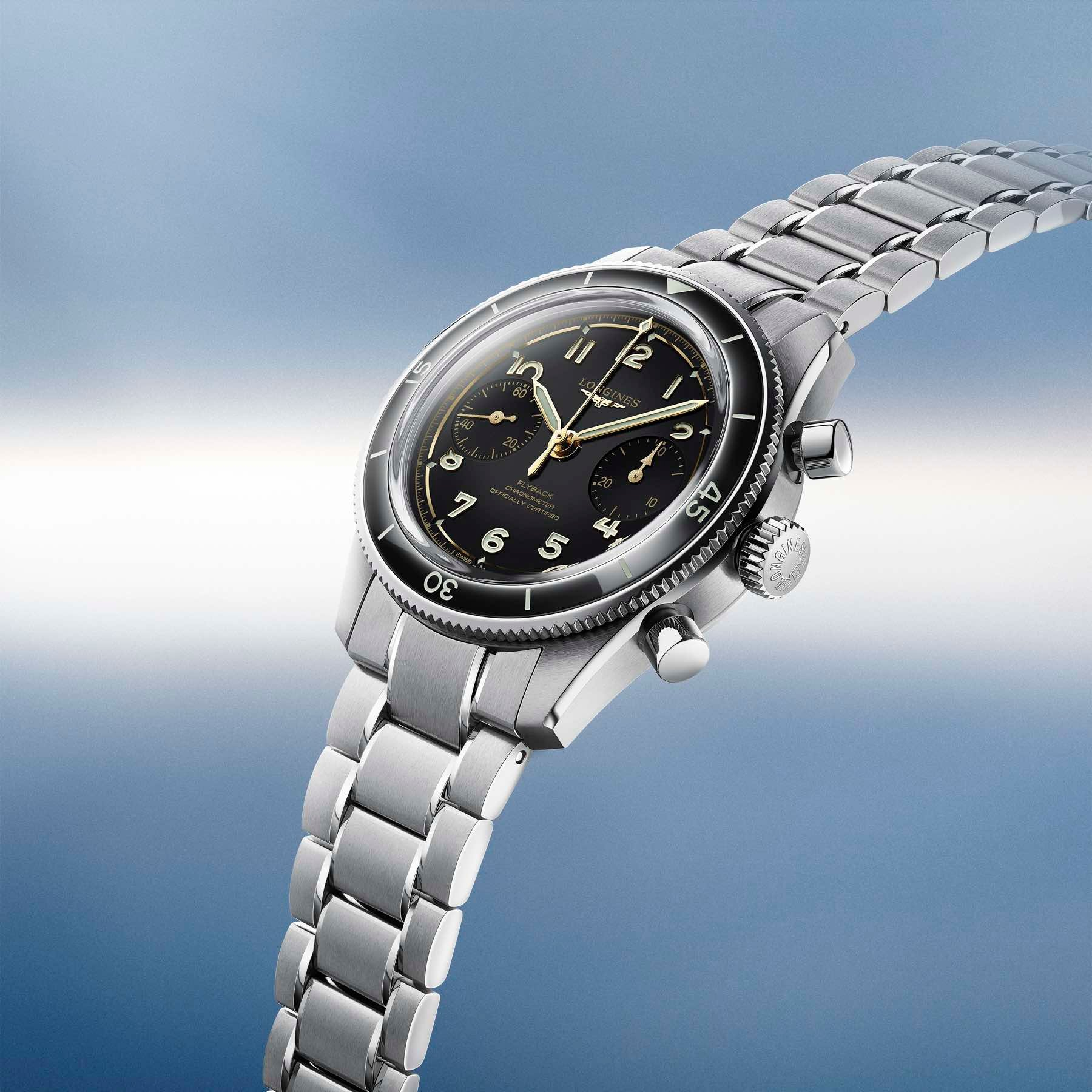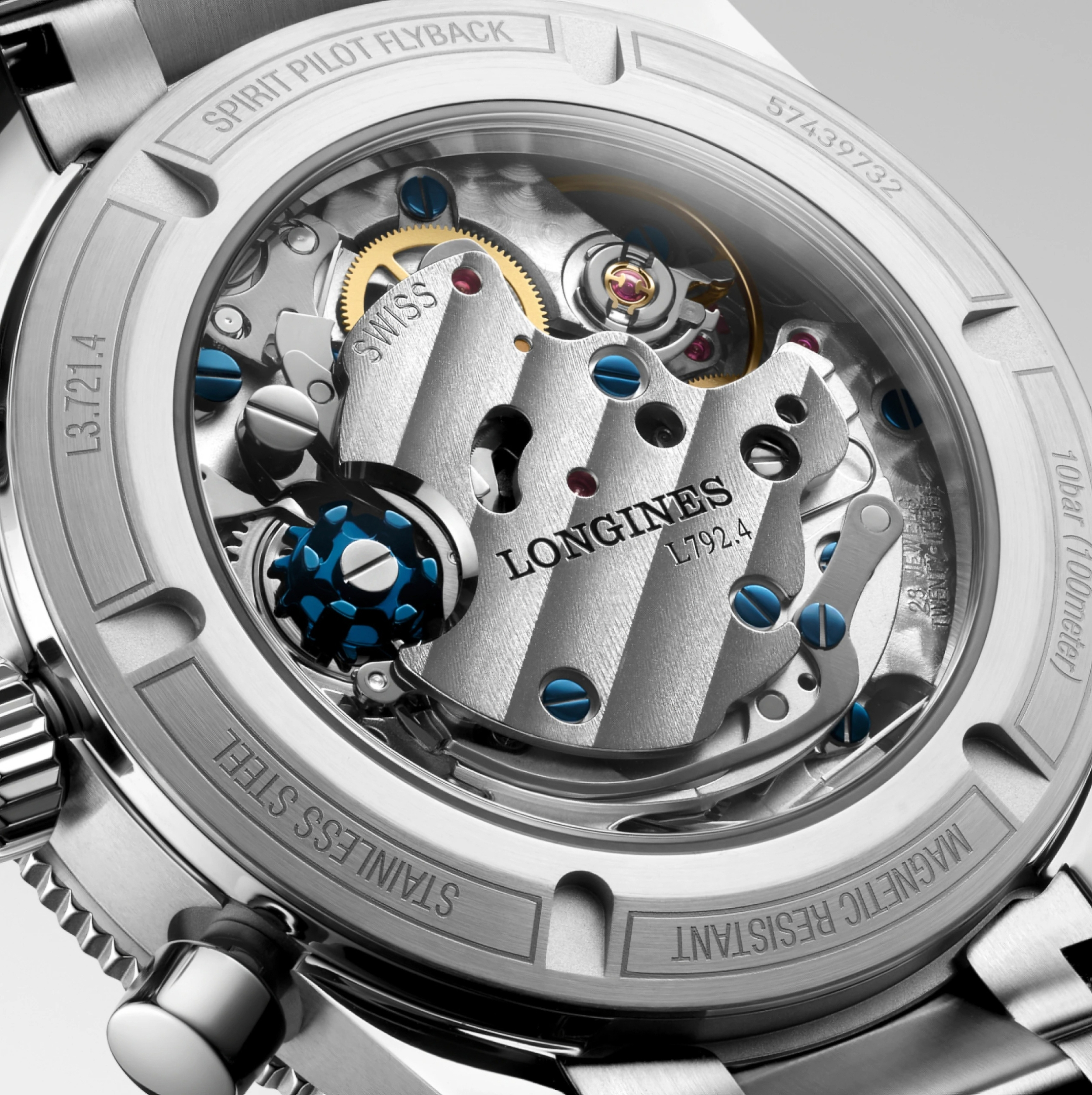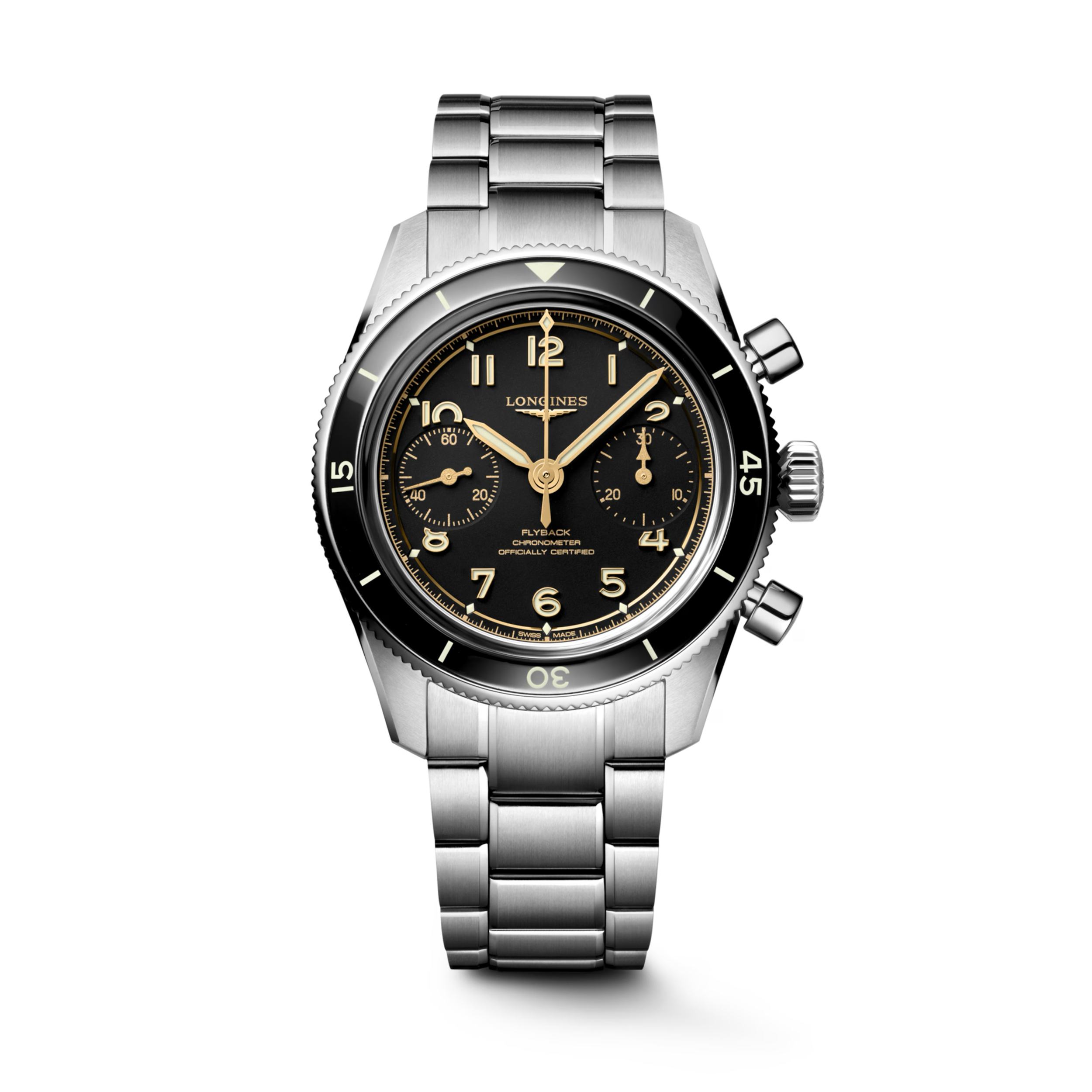Longines must be listening to feedback, because they’ve taken a good design and elevated it toward greatness, in a way that suggests they’re listening.
As they did with their standard three-hand Spirit Pilot watch, for 2025, Omega’s sibling, Longines, introduced a much more refined version of its Spirit Pilot Flyback Chronograph.
Starting with a new ETA-sourced movement (Swatch Group owns ETA, Longines, and Omega, among others) that forgoes the automatic oscillating weight in favor of a hand-wound chronograph design, Longines was able to reduce the total case thickness by 4 mm, compared to its previous generation Spirit Pilot Flyback Chronograph.
This reduction in thickness is arguably more important than whether the watch has an automatic winding system or not. Trading away the ability to wind the watch by wearing it is a tradeoff that many well-informed consumers will likely accept.
Winding a watch by hand can actually be appreciated, depending on your use case and preferences. I personally don’t mind it, especially with a chronograph, where there’s so much going on that I prefer it to be hand-wound.
With a dive watch, I tend to prefer an automatic. And while one of the most coveted and collectible chronographs on planet Earth, the Rolex Daytona, is an automatic. A counterpoint is that one of the other most collectible chronographs from here to the moon, the Omega Speedmaster Professional Moonwatch, is a manually wound chronograph.
With a power reserve of 68 hours, that’s 18-20 hours longer than the venerable Speedmaster Professional (depending on which model), so even if you have to wind it, you can do so less often.
Longines reportedly has a dedicated section at ETA to manufacture the movements, which is not necessarily as respected as having a dedicated in-house manufacture, however, they’re producing at a very high volume that may make this the only viable option currently.
Based on Morgan Stanley’s latest ranking report, Longines ranked number 7 amongst Swiss watchmakers by sales revenue in 2024, which is huge. That puts them well within the scale needed to operate their own factory; however, the Swatch Group must have a reason for keeping their movement production at ETA. Whether that’s because ETA is still the most cost-effective option, or because they want to restrict in-house manufacturing to Omega and above (Breuget, Blancpain), to maintain exclusivity, or both, or some other reason altogether, is unclear.
This watch is a modern COSC-certified chronometer that beats at 4Hz, has a silicon balance spring (which lengthens service intervals and reduces negative magnetism). Each chronometer movement is individually regulated to a rate of -4/+6 or better and tested by COSC before being cased up, ensuring that you’re buying a timepiece that delivers precise timekeeping.
This is far from an exotic movement; however, not all chronographs feature a column-wheel actuation mechanism (this one operates with a horizontal clutch), and few offer flyback functionality. A flyback allows you to start and stop the watch with the traditional pusher at 2 o’clock; however, unlike with a typical chronograph, where the 4 o’clock pusher only resets the chronograph, if the chronograph is running, and you hit the reset button, it actually stops, resets, and restarts all at once. And if the chronograph is stopped, and you hit the reset button, it simply resets.
Longines decorated caliber L792.4 with perlage on the mainplate, as well as blued screws, a blued column wheel, and stripes on the upper bridge, which elevates it compared to industrial movements with little to no finishing. And there’s a screw-in sapphire crystal caseback to view all the details.
As for the dial, Longines removed the 5-stars seen on previous Spirit Pilot models, in favor of a cleaner, matt black dial, with just the Longines logo in gilt print at 12 o’clock, with the winged hourglass emblem applied underneath it.
Longines also got rid of the third register at 6 o’clock, which, although useful, cluttered the dial compared to the new two-register look.
Longines kept the long index-shaped hour and minute hands, and the same long, thin, triangular-tipped chronograph seconds hand; however, they removed the red varnish from the tip, and the red from the pad printed “FLYBACK” designation at 6 o’clock. The pyramid-shaped 30-minute chronograph hand, in the subdial at 3 o’clock, and the baton-shaped small running seconds hand at 9’clock, remain the same.
Everything from the applied Arabic indices, to the hands, to the minute/second scale, to the logos, and font, is gilded. This gives a vintage look, and future models could offer a non-gilded option, although this looks attractive as is.
Surrounding the dial is a stainless steel bi-directional rotating bezel, with a shiny black ceramic insert, that most notably, now has an appropriate for a pilot watch, countdown bezel, compared to a count-up (dive-style) bezel on prior models.
Last but not least, thanks to the new movement, Longines was able to offer this latest generation of Spirit Pilot Flyback Chronograph, in a 316L stainless steel case that measures a proportionally ideal 39.5 mm x 13.4 mm (compared to 42 mm x 17 mm before). The lug-to-lug is 47.4 mm, and the lug width is 20 mm. Longines tastefully added polished to the case flank bevels, to the crown, to the pushers, to the upper rim of the bezel, and in between the center links (on the bracelet version), with everything else receiving brushed surfaces.
The Spirit Pilot Flyback Chronograph is 100 meters water-resistant and weighs 155 grams with the stainless steel bracelet, which features a 3-position micro-adjustable clasp, but no quick-release spring bars (Ref. L3.721.4.53.6) and retails for $5,550. For $5,350, you get a brown leather strap with a 3-position micro-adjustable stainless steel clasp and quick-release spring bars.
Learn more at Longines.
Photos by Longines.





